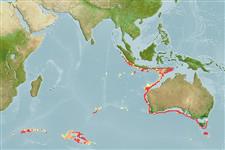Classification / Names
Common names from other countries
Main reference
Size / Weight / Age
Max length : 35.0 cm TL male/unsexed; (Ref. 35909)
Environment
Marine; bathydemersal; depth range 830 - 1500 m (Ref. 35909)
Climate / Range
Deep-water, preferred ?
Distribution
Short description
Dorsal
spines
(total): 2;
Anal
spines: 0. Pelvic fin rays 10-11; first dorsal fin with 10 or 11 segmented rays (rarely 12); underside of snout with broad naked median swath, pores of lateralis system small, inconspicuous; body scales covered with narrow, lanceolate spinules in slightly convergent rows; 7-9.5 scale rows below origin of second dorsal fin, 36-41 lateral line scales over distance equal to predorsal length; trunk lacking prominent broad dark girdle; first dorsal fin all black; anterior dermal window of light organ more or less on transverse line connecting pelvic fin insertions; upper jaws 29-33% of HL; orbit to preopercular distance 33-38% of HL; inner gill rakers on first arch 10-13.
IUCN Red List Status (Ref. 115185)
Human uses
More information
Common namesSynonymsMetabolismPredatorsEcotoxicologyReproductionMaturitySpawningFecundityEggsEgg development
Age/SizeGrowthLength-weightLength-lengthLength-frequenciesMorphometricsMorphologyLarvaeLarval dynamicsRecruitmentAbundance
ReferencesAquacultureAquaculture profileStrainsGeneticsAllele frequenciesHeritabilityDiseasesProcessingMass conversion
Tools
Special reports
Download XML
Internet sources
Estimates of some properties based on models
Phylogenetic diversity index
PD50 = 0.5000 many relatives (e.g. carps) 0.5 - 2.0 few relatives (e.g. lungfishes)
Trophic Level
3.3 ±0.1 se; Based on size and trophs of closest relatives
Resilience
Medium, minimum population doubling time 1.4 - 4.4 years (Preliminary K or Fecundity.)
Vulnerability
Moderate vulnerability (43 of 100)
Price category
